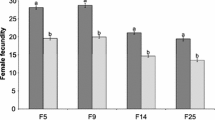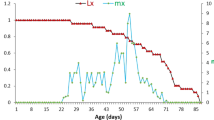Abstract
Spalangia cameroni Perkins (Hymenoptera: Pteromalidae) is used as a biological control agent against house flies and stable flies in livestock farms in Northern Europe. In the present study, the juvenile development, survival, and sex ratio of one Danish and one Norwegian population of S. cameroni were investigated at 15, 20, 25, 30, and 35°C to determine the best adapted strain for release programs. The Danish population developed 50 days faster at 15°C, whereas the Norwegian developed 3–4 days faster at 25°C. The difference was smaller at 20°C and 30°C. Only a few Danish female parasitoids emerged at 35°C. Both populations required 381 degree days to complete development and exhibited optimal juvenile survival at 23.7°C. The Norwegian population produced more females than the Danish population at all temperatures (average of 67.5% vs. 55.5%, respectively). The overall differences between the populations were small, but might still be important for inundative release programs.





Similar content being viewed by others
References
Ables RJ, Shepard M (1976) Influence of temperature on oviposition by parasites Spalangia endius and Muscidifurax raptor. Environ Entomol 5:511–513
Birkemoe T, Øyrehagen H (2010) Parasitism of the house fly parasitoid Spalangia cameroni on Norwegian pig farms: local effect of release method. BioControl 55:583–591
Birkemoe T, Soleng A, Riddervold KW (2004) Abundance of parasitoid Hymenoptera on pupas of Musca domestica and Stomoxys calcitrans (Diptera, Muscidae) on pig farms in Vestfold, Norway. Nor J Entomol 51:159–164
Birkemoe T, Soleng A, Aak A (2009) Biological control of Musca domestica and Stomoxys calcitrans by mass releases of the parasitoid Spalangia cameroni on two Norwegian pig farms. BioControl 54:425–436
Briere JF, Pracros P, Le Roux AY, Pierre JS (1999) A novel rate model of temperature-dependent development for arthropods. Environ Entomol 28:22–29
Crespo DC, Lecuona RE, Hogsette JA (1998) Biological control: an important component in integrated management of Musca domestica (Diptera: Muscidae) in caged-layer poultry houses in Buenos Aires, Argentina. Biol Control 13:16–24
Floate KD (2002) Production of filth fly parasitoids (Hymenoptera: Pteromalidae) on fresh and on freeze-killed and stored house fly pupae. Biocontrol Sci Tech 12:595–603
Floate KD, Skovgård H (2004) Winter survival of nuisance fly parasitoids (Hymenoptera : Pteromalidae) in Canada and Denmark. Bull Entomol Res 94:331–340
Geden CJ (1996) Modeling host attacks and progeny production of Spalangia gemina, Spalangia cameroni, and Muscidifurax raptor (Hymenoptera: Pteromalidae) at constant and variable temperatures. Biol Control 7:172–178
Geden CJ (1997) Development models for the filth fly parasitoids Spalangia gemina, S. cameroni, and Muscidifurax raptor (Hymenoptera: Pteromalidae) under constant and variable temperatures. Biol Control 9:185–192
Geden CJ, Hogsette JA (2006) Suppression of house flies (Diptera: Muscidae) in Florida poultry houses by sustained releases of Muscidifurax raptorellus and Spalangia cameroni (Hymenoptera: Pteromalidae). Environ Entomol 35:75–82
Geden CJ, Kaufman PE (2007) Development of Spalangia cameroni and Muscidifurax raptor (Hymenoptera: Pteromalidae) on live house fly (Diptera: Muscidae) pupae and pupae killed by heat shock, irradiation, and cold. Environ Entomol 36:34–39
Gerling D, Legner EF (1968) Developmental history and reproduction of Spalangia cameroni, parasite of synanthropic flies. Ann Entomol Soc Am 61:1436–1443
Guzman DR, Petersen JJ (1986) Cold acclimation and prolonged low temperature survival of filth fly parasites (Hymenoptera: Pteromalidae). Environ Entomol 15:936–942
Heimpel GE, Lundgren JG (2000) Sex ratios of commercially reared biological control agents. Biol Control 19:77–93
Klunker R (1994) On the occurence of puparium parasitoids as natural enemies of house flies. Appl Parasitol 35:36–50
Larsen EB, Thomsen M (1940) The influence of temperature on the development of some species of Diptera. Vitensk Medd Dan Naturhist Foren 104:1–75
Legner EF (1977) Temperature, humidity and depth of habitat influencing host destruction and fecundity of muscoid parasites. Entomophaga 22:199–206
Legner EF (1988) Hybridization in principal parasitoids of synanthropic Diptera—the genus Muscidifurax (Hymenoptera, Pteromalidae). Hilgardia 56:1–36
Legner EF (1995) Biological control of Diptera of medical and veterinary importance. J Vector Ecol 20:59–120
Lysyk TJ (1998) Relationships between temperature and life-history parameters of Stomoxys calcitrans (Diptera: Muscidae). J Med Entomol 35:107–119
Lysyk TJ (2000) Relationships between temperature and life history parameters of Muscidifurax raptor (Hymenoptera: Pteromalidae). Environ Entomol 29:596–605
Mann JA, Axtell RC, Stinner RE (1990) Temperature-dependent development and parasitism rates of 4 species of Pteromalidae (Hymenoptera) parasitoids of housefly (Musca domestica) pupae. Med Vet Entomol 4:245–253
Morgan PB, Patterson RS, LaBreque GC, Weidhaas DE, Benton A (1975) Suppression of a field population of houseflies with Spalangia endius. Science 189:388–389
Morgan PB, Hoyer H, Patterson RS (1989) Life history of Spalangia cameroni (Hymenotpera: Pteromalidae), a microhymenopteran pupal parasite of muscoid flies (Diptera: Muscidae). J Kans Entomol Soc 62:381–386
SAS Institute (2009) SAS user's guide: statistics. SAS Institute, Cary, NC
Skovgård H (2004) Sustained releases of the pupal parasitoid Spalangia cameroni (Hymenoptera: Pteromalidae) for control of house flies, Musca domestica and stable flies Stomoxys calcitrans (Diptera: Muscidae) on dairy farms in Denmark. Biol Control 30:288–297
Skovgård H, Jespersen JB (1999) Activity and relative abundance of hymenopterous parasitoids that attack puparia of Musca domestica and Stomoxys calcitrans (Diptera: Muscidae) on confined pig and cattle farms in Denmark. Bull Entomol Res 89:263–269
Skovgård H, Jespersen JB (2000) Seasonal and spatial activity of hymenopterous pupal parasitoids (Pteromalidae and Ichneumonidae) of the house fly (Diptera: Muscidae) on Danish pig and cattle farms. Environ Entomol 29:630–637
Skovgård H, Nachman G (2004) Biological control of house flies Musca domestica and stable flies Stomoxys calcitrans (Diptera: Muscidae) by means of inundative releases of Spalangia cameroni (Hymenoptera: Pteromalidae). Bull Entomol Res 94:555–567
Skovgård H, Steenberg T (2002) Activity of pupal parasitoids of the stable fly Stomoxys calcitrans and prevalence of entomopathogenic fungi in the stable fly and the house fly Musca domestica in Denmark. BioControl 47:45–60
Tormos J, Beitia F, Alonso M, Asis JD, Gayubo SF (2010) Assessment of Ceratitis capitata (Diptera, Tephritidae) pupae killed by heat or cold as hosts for rearing Spalangia cameroni (Hymenoptera: Pteromalidae). Ann Appl Biol 156:179–185
Wagner TL, Wu H-I, Sharpe PJH, Schoolfield RM, Coulson R (1984) Modeling insect development rates: a literature review and application of a biophysical model. Ann Entomol Soc Am 77:208–225
Wilhoit LR, Stinner RE, Axtell RC, Bacheler JE, Mann JA (1991) Parmod—a simulation-model for the population-dynamics of Muscidifurax spp and Spalangia spp (Hymenoptera, Pteromalidae), parasites of house-fly pupae (Diptera, Muscidae). Environ Entomol 20:1418–1426
Acknowledgments
We are grateful for the technical support in the laboratory by Karen Riddervold and Nina Huynh (NIPH) and Bjarne Nielsen, Gitte Jensen, Claus Dahl, and Aase Borges (DA).
Author information
Authors and Affiliations
Corresponding author
Additional information
Handling Editor: Stefano Colazza
Rights and permissions
About this article
Cite this article
Birkemoe, T., Soleng, A. & Skovgård, H. Life history parameters of two geographically separated populations of Spalangia cameroni, a microhymenopteran pupal parasitoid of muscoid flies. BioControl 57, 375–385 (2012). https://doi.org/10.1007/s10526-011-9406-2
Received:
Accepted:
Published:
Issue Date:
DOI: https://doi.org/10.1007/s10526-011-9406-2




